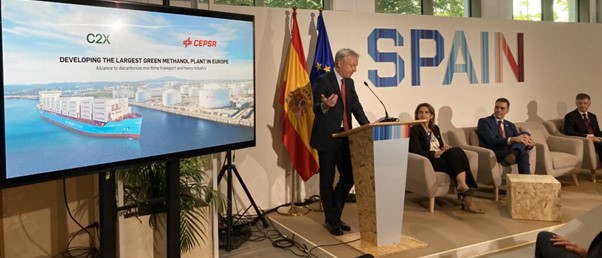The construction of a green methanol plant in the Port of Huelva, the result of collaboration between Cepsa and C2X, a Maersk subsidiary, marks a milestone in the energy transition of the maritime sector. This project is integrated into a broader context: the consolidation of the Strait of Gibraltar as a key energy hub for the supply of sustainable fuels.
January 10, 2024
Cepsa and C2X have announced a strategic agreement to build and operate what is expected to be the largest green methanol production plant in Europe, located in the Port of Huelva. The plant will have an annual production capacity of 300,000 tons of green methanol. The estimated investment for the project amounts to 1,000 million euros, with a forecast of generating 2,500 jobs, both direct and indirect. The final investment decision will be made in 2025, and the plant is expected to be operational by 2028.

Green methanol will be produced from green hydrogen and captured carbon dioxide. Green hydrogen will be generated using renewable energy, while carbon dioxide can be obtained from industrial sources or directly from the air. This production process results in a fuel with a significantly lower carbon footprint compared to traditional fossil fuels used in shipping.
Strategic Advantages and Challenges
The location of the plant in the Port of Huelva offers strategic advantages. The port has well-developed infrastructure and connections to major shipping routes, facilitating the distribution of green methanol to customers. Furthermore, the proximity to the Andalusian Green Hydrogen Valley, a project led by Cepsa, ensures the supply of green hydrogen necessary for the production of methanol.
However, the project faces challenges, such as the need to produce green hydrogen at a competitive cost, develop adequate bunkering and supply infrastructure, and adapt the maritime fleet to use green methanol as fuel.
The Strait of Gibraltar as an Energy Hub
The Strait of Gibraltar, due to its geographical location as a gateway to the Mediterranean and connection between Europe and Africa, has historically been a strategic point for bunkering, the supply of fuel to ships. Its intense maritime traffic and the presence of ports such as Algeciras, Ceuta and Gibraltar make it an ideal place for this activity. The transition to low carbon fuels opens new opportunities for the Strait of Gibraltar. The region has great potential for the generation of renewable energy, both solar and wind, which can be used for the production of green hydrogen and green methanol.
The Cepsa and C2X plant in Huelva, together with other projects in development, positions the Strait of Gibraltar as a key energy hub for the supply of sustainable fuels to international maritime transport.
Maersk Strategy and Stakeholder Reactions
Maersk, one of the world's leading shipping companies, has opted for green methanol as the fuel of the future for its fleet. The company has placed orders for container ships capable of operating on green methanol and has committed to achieving carbon neutrality by 2050.
Maersk's decision to opt for green methanol is based on several factors, such as the availability of the technology, the scalability of production and the significant reduction of greenhouse gas emissions. The company considers green methanol to be a viable and sustainable solution for the long-term decarbonization of shipping.
The agreement with Cepsa for the production of green methanol in Huelva is an important step in Maersk's strategy. The plant will ensure the supply of green methanol to Maersk's fleet and will contribute to the creation of a global supply chain for this sustainable fuel. The project has received extensive support from local and regional authorities, as well as major players in the maritime sector.

